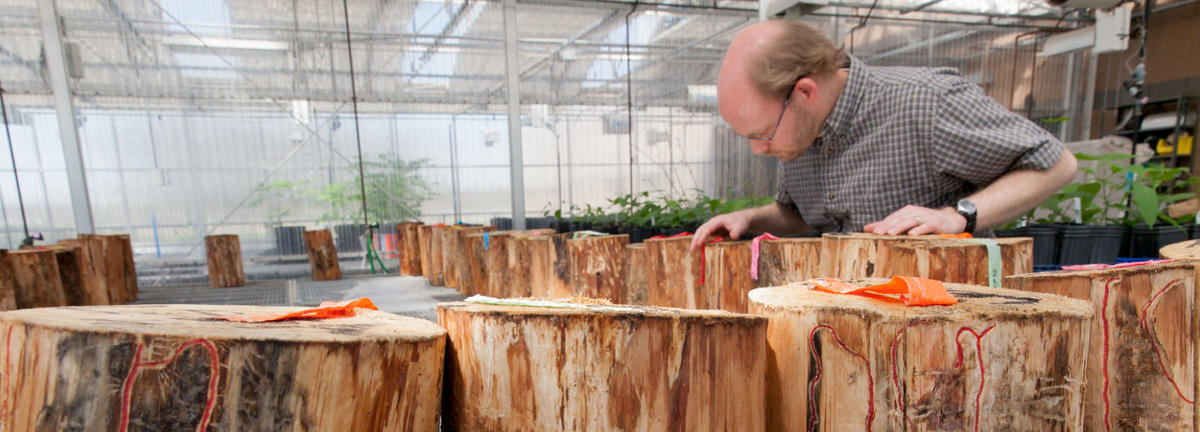
Researcher Brian Aukema studies mountain pine beetle in a lab
Background
The mountain pine beetle (Dendroctonus ponderosae Hopkins) has killed millions of acres of pine forest in the western US and Canada. Although physical distance and cold temperatures have kept it outside of Minnesota, barriers are quickly breaking down as the timber trade expands and the climate continues to warm. Dead beetles have already turned up in wood imported to the state. Mountain pine beetle now ranks as Minnesota's number one invasive insect threat.
This project will develop a monitoring system, based on pheromone-baited traps, to facilitate early detection of mountain pine beetles in the state. It will also explore whether the mountain pine beetle could have any native predators or competitors in Minnesota, and how strong Minnesota pines' defense response would be against infection. Together, this information will help scientists and managers build a plan of action for eradication.
Research questions
- Can mountain pine beetle monitoring be improved with new pheromone-baited traps?
- Do competitor or predator insect species also respond to the presence of mountain pine beetle pheromone – providing another way to keep mountain pine beetle out of the state?
- How susceptible are Minnesota’s pine species to the mountain pine beetle, as measured by trees’ natural resistance to the disease-causing fungi spread by the insect?
Outcomes
Repeated surveys did not find mountain pine beetles in Minnesota. Scant few individuals were captured dispersing far from active infestations in western states. We found that local bark beetles and predators do not optimally recognize the insect’s chemical signals, however, suggesting that such components of invasion resistance might be low. Because we still lack knowledge about how mountain pine beetles persist in endemic states, and whether colonization densities might actually be lower in other species of Minnesota’s pines if they have lower defensive responses, continued vigilance against mountain pine beetle as a threat to Minnesota’s pine forests is warranted.
Publications
- Defensive response of evolutionarily naïve Pinus sylvestris to the mountain pine beetle fungal associate Grosmannia clavigera in comparison to Pinus ponderosa (Forest Ecology and Management, 2023)
- Colonization and reproduction of potential competitors with mountain pine beetle in baited logs of a new host for mountain pine beetle, jack pine (Forest Ecology and Management, 2021)
- Colonization behaviors of mountain pine beetle on novel hosts: Implications for range expansion into northeastern North America (PLoS ONE, 2017)
- Cold tolerance of mountain pine beetle among novel eastern pines: A potential for trade-offs in an invaded range? (Forest Ecology and Management, 2017)
Outreach and presentations
- Entomological Society of America
- IUFRO Conference on Biological Invasions in Forests
- North American Forest Insect Work Conference
- North Central Forest Pest Workshop
- Western Forest Insect Work Conference
- Upper Midwest Invasive Species Conference
- Sustainable Forest Education Cooperative
- State Forest Health Cooperators
- Northern Advanced Silviculture Program
- Minnesota Forest Industries
- MN Department of Natural Resources Forestry Team
News and media
- This tiny beetle could threaten Minnesota's forests (MPR News, 2022)
- Mountain pine beetle is No. 1 invasive insect priority (Park Rapids Enterprise, 2022)
- Mountain pine beetle (Fergus Falls Journal, 2022)
- Expecting the mountain pine beetle (MITPPC, 2022)